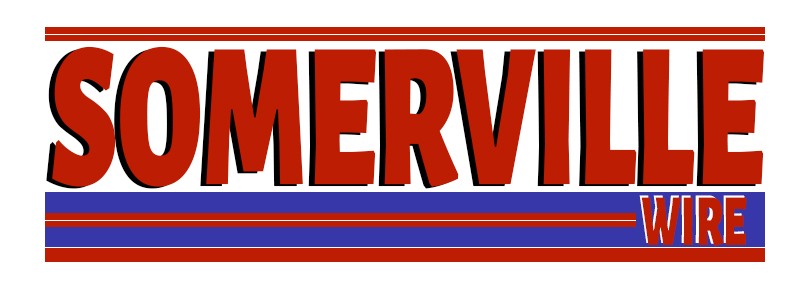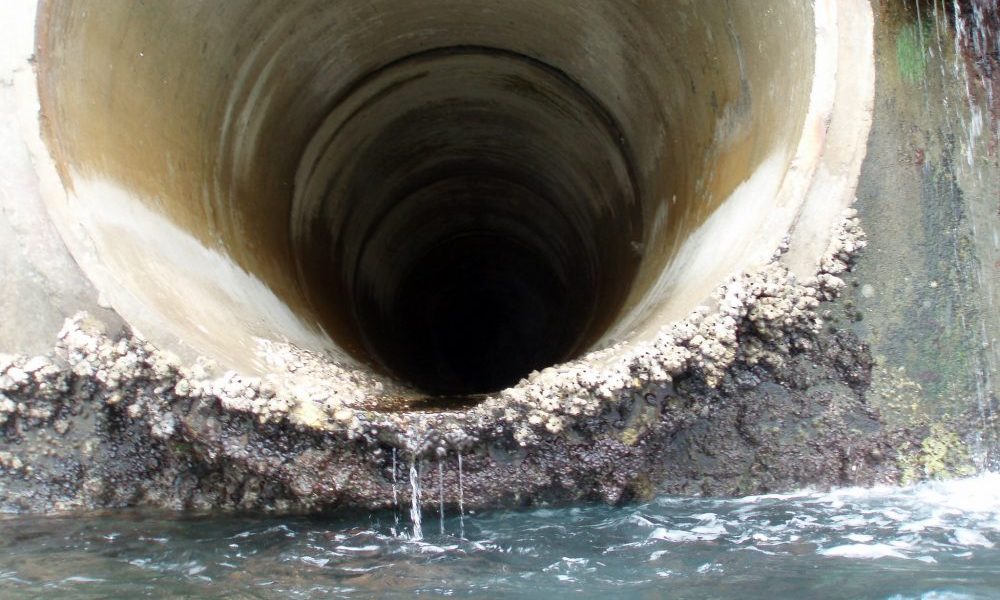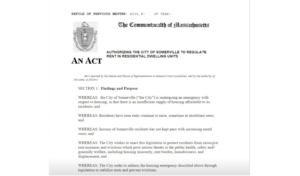Photo by Gerick Bergsma
Thanks to stormwater pollution, Dirty Water’s more than just a theme song. It’s a way of life.
In a pond near Durham, North Carolina, Partick Hogan saw fish drowning in water. They pushed their heads above the surface, opening their mouths as if they were about to scream, but instead gulped at the air. Hundreds of fish lie dead along the banks, unable to survive in the oxygen-depleted water. These water-breathing animals were desperate to breathe on land.
The Public Works department in Durham never discovered the cause behind the fish phenomenon, but Hogan, an engineer and water resource professional at the Neponset River Watershed Association, believes the culprit is stormwater: water runoff from rain and snow.
As rain and snow falls on lawns, roads and driveways, nitrogen and phosphorus from fertilizers and grass cuttings are picked up and sent to rivers and streams. In freshwater, phosphorus creates prime conditions for algae growth, causing an algal bloom. As the algae decays, it reacts with dissolved oxygen aquatic animals require to breathe.
Stormwater runoff is the largest pollutant of water in Massachusetts. According to EPA How’s My Waterway data: 16,756 acres of lakes and reservoirs in Massachusetts are unsafe for swimming; and 55,974 acres of lakes, an area size larger than Washington DC, house seafood dangerous for consumption.
As Northeastern winters become warmer and wetter, more pollutants will be carried off into nearby streams, lakes, and beaches. Local municipalities are led by water conservation nonprofits to prevent pollution from destroying aquatic ecosystems, but community members and state government administrators are still learning about the detriment of stormwater runoff.
“You go to the tap and you turn on the water, it’s there, and you expect it to be there,” Hogan said. “The same thing with the sewer, you expect that to work, you expect it not to have problems. Stormwater often goes so unnoticed unless there’s actually a problem that’s causing flooding or something like that, generally people don’t think about it very much.”
Fertilizers and organic waste are not the only waste in our rivers. Oils and rubber from cars, microplastics, pharmaceuticals, caffeine, and E.Coli from feces all washes from storm drains into our freshwater and saltwater.
“Whenever you have people, you need water,” Timothy Randhir, a UMass Amherst professor researching water management and watershed systems, said in an interview. “And when they have water, there’s always pollution issues.”
Hitting the pavement
Despite the state’s efforts to control water pollution and stormwater runoff, Randhir said the issue has persisted due to urbanization. Stormwater cannot absorb into impervious surfaces like concrete and asphalt: the more land covered by buildings and roads, the less water is able to permeate into the ground and filter out the increased amount of pollutants from the surrounding developments.
Many New England storm drains and sewage systems were not built to sustain the amount of runoff stormwater overwhelms water systems. For instance, Greater Boston is 80% paved, and according to the First Street Foundation’s interactive flood map, the Hub is at much higher risk for flooding than other areas, about four times the amount of property is at risk than previously predicted by other reports. All that flood water picks up pollution and poisons local water bodies.
The uptick in impervious surface is only exacerbated by the decrease in snowfall and increase in rainfall during Massachussett’s winters. By the year 2050, a flood that typically occurs once in 100 years will occur every one to two years.
“If your snow is essentially melting earlier and faster, everything is actually running off as storm runoff, and … much of the high rainfall or the runoff happening like that now moves earlier,” Randhir said.
The impact of stormwater pollution on water ecosystems was enough to drop the Charles River’s EPA grade from an A- to a B in 2019. In response, Hogan and his team at the Neponset River Watershed Association, a grassroots nonprofit that cleans and protects the Neponset River, made stormwater a top priority.
Before coming to Mass, Hogan managed stormwater in Roanoke, Virginia and Dunham, North Carolina, so he knows all about runoff pollution. The problems this region presents, however, are unlike those he contended with at past jobs.
“I’ve worked in some very urban areas, but this is probably the most densely developed area that I’ve worked in,” Hogan said. “I’d also say, working with the Neponset River Watershed Association, we look at the watershed as a whole. And the development in Quincy is very different from the development in, say, Canton or Sharon. You kind of got a spectrum of conditions with stormwater.”
The Neponset River Watershed Association created a Neponset Stormwater Partnership with Canton, Dedham, Foxborough, Medfield, Milton, Norwood, Quincy, Sharon, Stoughton and Westwood, whose water runoff feeds into the Neponset River. This program allows municipalities to learn, draft administrative documents, and implement stormwater regulations together. It also helps look at the watershed’s health as a whole.
Most of the stormwater mitigation work comes from local governments, which Hogan and his coworkers collaborate with to ensure that areas around the river are meeting state guidelines as written in stormwater permits, specifically the Massachusetts MS4 permit that details strict stormwater pollution prevention requirements.
“We’ve been lucky that all the municipalities that I’ve worked with are aware of these issues and want to fix them,” Hogan said. “It’s not that we’re trying to convince somebody to fix them, usually they want to fix them. We’re just helping them figure out how.”
The MS4 permit currently requires new or redesigned best management practices (BMPs) for nitrogen, phosphorus, and heavy metal removal. BMPs are simply any technology that can interrupt the flow of water in the stormwater piping system to allow for filtration of heavy metals, nutrients, and pathogens. The most common BMP would be a rain garden, which can filter 310 gallons of water if it’s six-inches deep.
The permit also enforces proper removal of grass clippings and pet waste, more street sweeping to pick up excess sand, oil and salt, and identification of the amount of pollutants each BMP is expected to reduce. These regulations are a huge burden on local resources: the Massachusetts Coalition for Water Resources Stewardship, an organization that focuses on watershed conservation policies for stormwater, wastewater, and drinking water, argues that the EPA puts extreme pressure on small towns to clean their local water bodies quickly, with little consideration of the ecosystem or the town’s resources. Hogan’s job is to take all these regulations and help municipalities fit them into an already-developed town.
Federal and state support to towns and cities for these projects can be sparse. The cost of pollution-reducing technology is especially a large burden: The Massachusetts Water Infrastructure Finance Commission (WIFC), a state government oversight body, predicts that potential federal stormwater mandates could cost up to $18 billion for the state. On average, an acre of BMP development costs $50,000.
Permeable infrastructure
When it comes to getting support for BMP developments, local nonprofits connect with activists like Katharine Lange at the Massachusetts Rivers Alliances, an organization that acts as a bridge between the state government and the local watershed groups. The nonprofit advocates for funding of green infrastructure through government grants and bills, including the American Rescue Plan. Grants are key for Hogan to push stormwater projects through to municipalities.
“Generally the grants really help [cost concerns] out and they help, selling that to [governments]. If you’re putting in 40% of the cost but you’re getting 100% of the benefit usually that goes over pretty well,” Hogan said.
Lange educates state legislators on various watershed issues, including stormwater. She is a major proponent of green infrastructure, a type of BMP that allows the ground to filter out pollutants and restore groundwater. Rain gardens, permeable pavement, and bioswales all fall under the umbrella of green infrastructure. Lange also notes that green infrastructure combats other climate issues.
“You have the huge aesthetic benefit, it reduces the urban heat island effect, makes it more comfortable for pedestrians and other folks who are on the sidewalk in the public sphere [and] helps for pollinators and increases species diversity,” Lange said.
Many BMPs have become engineered to increase their efficacy. For instance, permeable pavement, a type of green infrastructure with pores in the pavement to allow water to soak through, had to withstand freezing temperature to be cost-effective and effective. Now, there are permeable pavements with various structures depending on your climate, and these can be used to cover roads, sidewalks, and parking lots that hold a lot of stormwater pollution.
Lange sometimes sees pushback when she advocates for installations of rain gardens, bioswales, and native vegetation gardens. She questions grey infrastructure, man made technologies that control water like pipelines and reservoirs, and says lawmakers’ reluctance to support green building is largely due to ignorance.
“I think some of those green infrastructure solutions that help with storm water are sometimes still new to people in the decision-making rooms, and they haven’t seen them be effective at scale,” Lange said.
Randhir also sees a huge disconnect between the scientific findings on stormwater management and their application. For instance, the MS4 permit gives specific percentages of phosphorus reduction for major water bodies. Clean up pollution at the site, however, does not accomplish much.
“What we miss is a systemwide perspective of looking at the whole watershed system and seeing where the sources are coming from and trying to treat them at the source. And then, to catch them during the transfer,” Ranhir said.
There’s also NIMBY backlash from community members.
“Even [with] planting a tree in a big city, there’s a lot of resistance,” Randhir said. “Even though it has a lot of [benefits], it can mitigate your stormwater runoff, it can improve your soil quality, it can sequester carbon, all those things. How many people would like to have free trees planted in the backyard or front yard, you will see that it’s not 100%.”
Community resistance is why watershed associations work to educate the public on stormwater. Understanding the issue, experts say, is critical not only for better solutions and community awareness, but because Lange believes the biggest victim of stormwater pollution is not the fish or the otters or the forest animals, but people.
“You know, if you are getting rid of excess household chemicals or paints or something from your garage, and you’re putting it in the driveway, just know that it’s going into your nearest water body,” Lange said.
“If you wouldn’t want to swim in it, if you wouldn’t want to eat a fish that had drank that or had your dog to go lap it up, you probably shouldn’t dump it on the ground.”
This article was produced in collaboration with the Boston Institute for Nonprofit Journalism.





